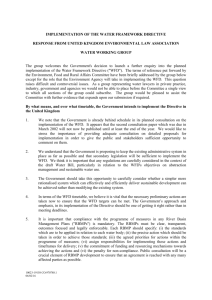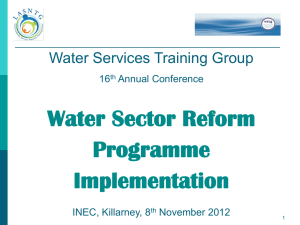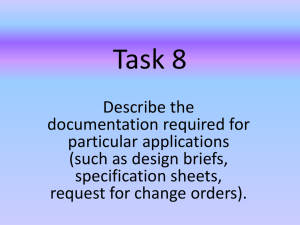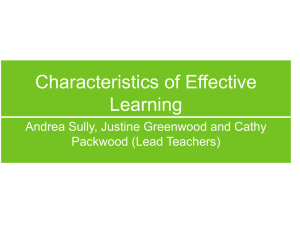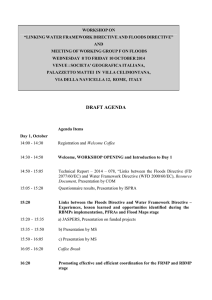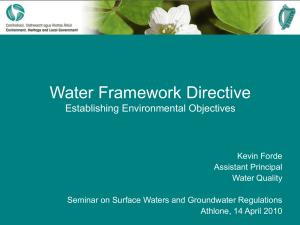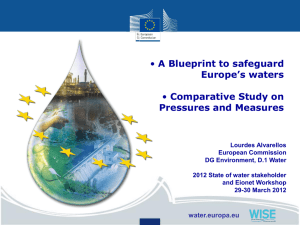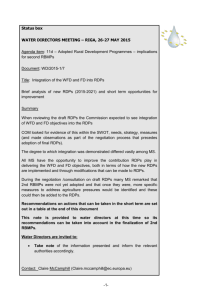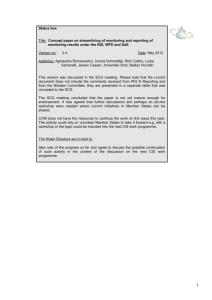lessons learned from wfd reporting and follow-up - CIRCABC
advertisement
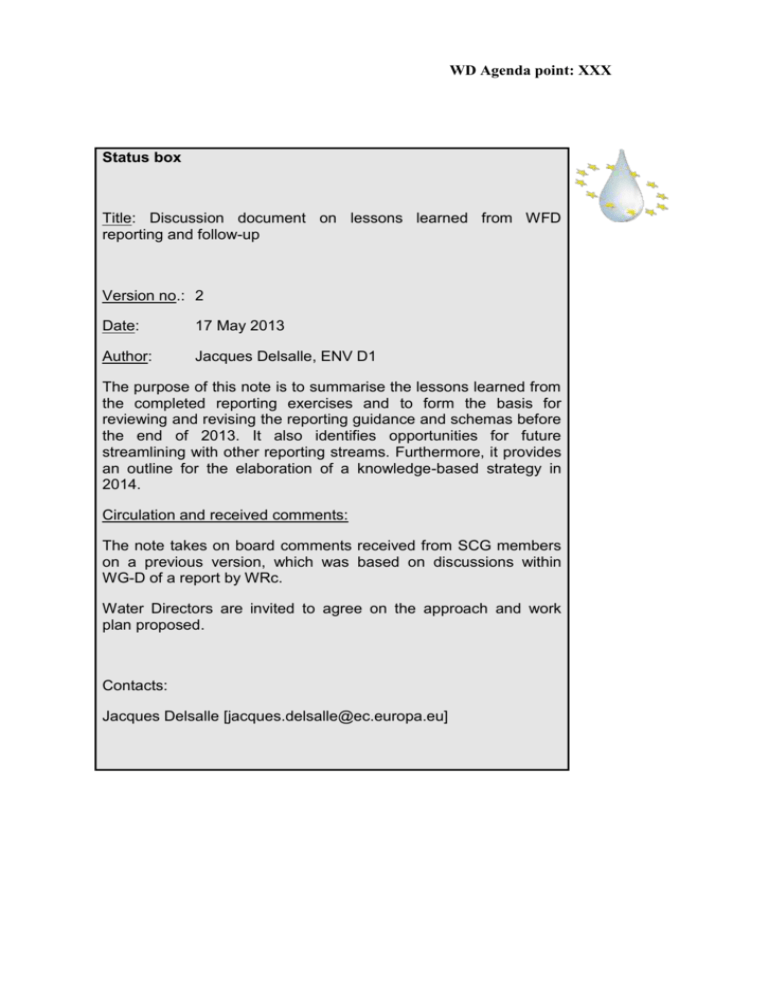
WD Agenda point: XXX Status box Title: Discussion document on lessons learned from WFD reporting and follow-up Version no.: 2 Date: 17 May 2013 Author: Jacques Delsalle, ENV D1 The purpose of this note is to summarise the lessons learned from the completed reporting exercises and to form the basis for reviewing and revising the reporting guidance and schemas before the end of 2013. It also identifies opportunities for future streamlining with other reporting streams. Furthermore, it provides an outline for the elaboration of a knowledge-based strategy in 2014. Circulation and received comments: The note takes on board comments received from SCG members on a previous version, which was based on discussions within WG-D of a report by WRc. Water Directors are invited to agree on the approach and work plan proposed. Contacts: Jacques Delsalle [jacques.delsalle@ec.europa.eu] 1. PURPOSE OF THE NOTE The purpose of this note is to summarise the lessons learned from the completed reporting exercises under the WFD and to form the basis for reviewing and, if necessary, revising the reporting guidance, sheets and schemas before the end of 2013. It also identifies opportunities for future streamlining with other reporting streams. Furthermore, it provides an outline for the elaboration of a knowledge-based strategy in 2014. This note is a revised version of the note discussed at the SCG meeting on 2/5/2013. It takes into account comments received either orally during the meeting or in writing after the meeting. It is based on an independent report from WRc1, discussions at theWGD meeting on 15/4 and additional comments sent in writing by WGD members2. 2. LESSONS LEARNED 2.1. What do we (all) need to know? The first reporting cycle and the related assessment by the Commission and the EEA was overall a positive exercise where all stakeholders have progressed a great deal in understanding the state of EU waters. However, it also resulted in a heavy workload, both at Member State and EU level, and further efforts are needed to ensure exchange of information and better understanding. This is due mainly to the novelty of the process and the length of time (some 6 years) between the start of the development of the reporting guidance and the information being analysed. It is clear that there is room for improvement in enhancing the exchange of data between Member states and the Commission in order to: i) have access to the right data for a proper assessment; ii) make available useful data; iii) make available the right data in order to better support the development of EU policy. Taking into account both MS and COMM experience from the first cycle, in compliance checking and visualising data in maps for the public, we should be able to identify the areas that need revision. Reporting less but more useful can be the motto. This implies taking account of the principle to report once and use many times, reducing administrative burden both in terms of reporting for MS and of evaluation for the Commission/EEA. The output (i.e. tables and maps) can now be defined clearly in advance, so that the Commission can ask for exactly the data and information that are needed to reach this target. Streamlining of reporting and further assessment processes have to be achieved. The reporting guidance and schemas should therefore be reviewed and refined, based on the experience of the first analysis, to enable MS to more accurately provide the information that the COM needs to carry out the assessment and provide the final output to WISE for the public. However, it is important to go beyond reporting and define the need for information exchange, in particular for benchmarking between River Basins or 1 Specific contract No 07.0307/2012/638468/D1 implementing Framework Contract ENV.D.1/FRA/2012/0014. Available on CircABC: https://circabc.europa.eu/d/a/workspace/SpacesStore/eae63d29-91ed-41b9-8e23bbef4f377e97/7b%20-%20ENV-SCG0205138%20annex%20WRc%20report%20on%20lesssons%20learned%20wfd%20reporting.doc 2 AT, BE, DE, ES, FR, IE, RO and SE. 2 Member States for some essential subjects /topics to be identified. The data available in WISE needs to be made available for handling this benchmarking and for simplifying the reporting requirements. For the next reporting cycle, extra attention should be paid to reusing some of the good practices of EEA reporting or reporting under other directives. The challenge of integrating INSPIRE directive obligations into the current setup should also be considered and integrated into the discussion on schemas in the coming months. It has proved impossible to carry out a DPSIR-type analysis for the WFD due to the inconsistency in the level of aggregation of reporting of Pressures, Status, Impacts and Measures, and unclear definitions. However, a more detailed possibility to differentiate between level of significance of pressures would be helpful to draw a meaningful picture and to identify action areas and necessary measures on a European scale. This would also involve the proposed prognosis on expected status of water bodies in 2021 and 2027. An appropriate and consistent level of aggregation for reporting should therefore be agreed. In order to show improvements between the planning cycles, the question of the scale to which disaggregated pressures, changes in status, implementation of measures and their impact, have to be reported, shown and assessed, is an issue for discussion (at water body level vs. aggregates at river basin or sub-basin level). Another example is the work on EU water balances at sub-catchment level with monthly resolution that was carried out by the Commission and the EEA where strong data gaps appeared on river discharge (flow) data and the volume of water stored in surface or groundwater. The building of this water balances is a necessary condition for the production of water efficiency indicators required by the Resource Efficiency Roadmap. The Commission and the EEA continue to have a need to carry out in-depth assessment on new and emerging issues in the water field, and to identify how these are affecting the water environment and are being addressed by MS policies. The Commission also faces very frequent and time-consuming requests for detailed information from the European Parliament or citizens. WFD reporting could i.e. provide a valuable source of information to support these assessments, but in most cases, the information provided is not suited to the assessment, either because the information was not requested in the reporting sheets, or because the level of aggregation was not appropriate. Options for the provision of data with a higher level of detail need to be assessed with their advantages and drawbacks. In some cases it could be integrated in the reporting requirements. An alternative solution is to ensure the detailed information is made easily accessible either in the reports or in databases accessible in the Common Data Repository; in that case reporting guidance would define the minimum contents and clarify concepts & categories, but this would not be covered by electronic reporting. In the longer term this would ideally be covered by a higher degree of accessibility and interoperability of national/local databases. Complementing information on ecological and chemical status with more detailed information on specific parameters, which allow the display of improvements achieved, would better reflect improvements made, and provide positive messages e.g. to budgetary authorities that the money spent in water policy delivers tangible results. EC maps providing information on individual parameters would have a value added in this context. Reporting sheets could therefore include specific chemical or ecological status parameters. The reporting of supplementary/additional measures could be reviewed to make reporting easier and more consistent with the identification of significant pressures, and to take into account the structure and content of the reporting undertaken in 2012 on 3 progress with implementation of the programme of measures. To do so, it is necessary to first have a more common view on how to interpret and implement the concept of supplementary measures, between Member States and the Commission. 2.2. Synergies with other reporting streams Full use was not made of information reporting by MS for other Directives that can contribute to / benefit from the implementation of the WFD (UWWD, Nitrates, IED/EPRTR, Habitats Directive, MSFD, etc.). Work on reinforcing synergies between reporting streams should continue to fully implement the “report once, use many” principle rather than developing common reporting sheets. In the short term, the streamlining of reporting parameters should be supported by a common dictionary of European terms (or ontologies), building on the current process of streamlining nitrates reporting under WFD, NiD and SoE. However, this common ontology needs to be backed by a clear description of the outcomes required by each directive, how they relate to each other and the key reporting requirements required to demonstrate these outcomes. INSPIRE Data Specifications for Themes of Annex II & III are close to adoption by the Council and the EP. They have strong implications on WFD reporting sheets, and need to be properly reflected in the reporting schemas. Using the same IDs would also support inter-linkages of reporting information under different Directives, although the different degree of geographical aggregation e.g. for UWWTD and NiD requires the use of GIS applications to better understand the impact of basic measures on pressures and state of water bodies. 2.3. Consistency of the information, metadata and supporting documents In the 3 previous reporting exercises, for some Member States all the information required was not provided, or there was inconsistency between the information uploaded to WISE, published documents or other reporting streams. This made it difficult and time consuming to carry out the assessments required at a European level, and jeopardised the quality of the assessments. This can lead to information being misinterpreted and an incorrect assessment being made. Furthermore, in some cases where hyperlinks to further reference documents were provided, these did not work, or were links to general governmental web sites and not the specific document. Information on methodologies was generally under-reported and has had to be obtained by reference to specific documents as the textual summaries provided by MS were not of sufficient detail to enable an assessment to be carried out. There are a number of specific technical areas where there has been a difference in understanding of the requirements which has contributed to the incomparability of the information provided. The current text boxes with 5000 characters limitation enables neither a straightforward analysis of the reported information, nor a good explanation of methodologies. A solution for this issue could be to develop closed choice lists for a clear identification of the parts of the reports where further details are provided. 2.4. IT process In general, the use of schemas and ReportNet for the submission of information is working well with only small refinements required. The numerous requests to have 4 access to some disaggregated data illustrate the need to move to a decentralised reporting system. However, most MS are not yet able to extract XML files from their national systems, although a-priori under INSPIRE Directive they should already be able to do this even though the implementation rules are not complete. A mechanism to enable MS to progress in this area should therefore be identified. The Common Data Repository (CDR), the WFD master database and the RBMP assessment databases (the two latter managed so far by external consultants) are complex tools still lacking integration and efficient user interfaces that could provide very useful information, not only for the Commission/EEA, but also for Member States that are interested in benchmarking their performance with others. Streamlining these tools and providing on-line access for MS during the assessment period before the publication of the Commission report, may encourage the provision of better quality information “winwin”. While there is scope for adapting reporting schemas to support in-depth assessments, Member States and the Commission could engage in a higher degree of interoperability and accessibility to data produced at river basin or national level, hence avoiding official reporting schemes going beyond strict legal commitments. 3. WORK PROGRAMME 3.1. Timing The Guidance (Reporting, CIS, GIS, schema etc.) needs to be reviewed and refined in a number of areas in order to improve the understanding and, hence, the quality of the information required, introducing practical examples for each significant area resulting from the lessons learned from the previous WISE reporting. Member States are currently reviewing Article 5 analyses and collecting data on the basis of existing reporting sheets. It is therefore important that the changes made to the reporting sheets are compatible with and can be clearly linked to the previous reporting sheets. Most Member States have established national guidance for data providers that transcribes the framework of implementation of the WFD in data and information in accordance with the database requirements. For that, reporting sheets need to be ready by the end of 2013, while fully developed schemas need to be ready not later than mid-2014 to be used for the second cycle. In order to take into account INSPIRE requirements and improve consistency, the reporting guidance would already integrate the schemas3. Sequence and duration of necessary steps of preparation of the RMBPs only leave a narrow time frame, for instance public participation has to start in 2014 to enable the outcome to be incorporated in the plans. To ensure an enhanced reporting the bulk of the work has to be performed before the end of the year 2013; if not, reporting will remain essentially unchanged. While no additional 3 Such as those available in the User Guide to the WFD Reporting Schemas v4.3: http://icm.eionet.europa.eu/schemas/dir200060ec/resources/User%20Guide%20to%20the%20streamli ned%20schemas%20v4.3.pdf 5 reporting would be developed except for EQS, additional elements to existing reporting schemes will need the approval by MS at Water Directors in December 2013. 3.2. Principles The principles for the revision of reporting schemes would be: To clearly define the requirements, specifying exactly the data and information needed to be reported, on the basis of the requirements of the WFD and additional agreements approved by the water directors. To explore possibilities for additional information based on an identification of the outputs linked to compliance checking, EU-wide assessments and benchmarking (see section 2.1 above) To keep the main lines of reporting to be able to keep track of the progress. To simplify the schemas as much as possible. The limit and focus the changes made to the reporting sheets To harmonize the reporting scales. It is recommended that Member States ensure that those who will be responsible for providing the information to the COM are kept fully aware of the discussions and agreements that are being held at EU level. 3.3. Modus operandi On the basis of SCG and Water Directors discussions, it was agreed at the Working Group D meeting that a core drafting group would be working between June and October 2013 on the present document to review the Reporting Guidance and the Reporting Sheets. The following members of the WG have volunteered to be part of the drafting group: Ireland, Finland, Germany, Austria, France, The Netherlands and Spain. A meeting will take place early June to discuss the distribution of the workload. The work would take place mainly through teleconferences and document exchange. The draft results would be discussed at the next meeting of the WGD (under the new CIS configuration) in mid-October 2013. 4. KEY ISSUES TO BE TAKEN INTO ACCOUNT FOR GUIDANCE REVISION IN THE SHORT TERM The list below provides a starting point for the revision of the guidance and reporting sheets, in the light of the key issues for discussion mentioned in section 2 above (in particular scope and scale of the reporting/assessments, focus on revised reporting requirements vs. move to distributed systems). The most relevant issue to be discussed by the core drafting group will be the scope for simplification. On the basis of the lessons learned from the RBMP reporting and further assessment process, an attractive option providing answers to the problems identified above would be to apply a rather radical change in the philosophy of the electronic reporting, that would focus on providing a self6 assessment according to the contents of the Commission report, and on providing clear indication on the availability and completeness of the data that support this assessment, in the reports available in the Common Data Repository. This would enable a strong reduction of the administrative burden both for the Commission and the Member States, and a streamlining of the electronic reporting with the further assessment process and the bilateral meetings. 4 Many MS will review and revise the delineation of water bodies in the next planning cycle (in particular groundwater4). In order to ensure comparability, it is important that links can be made between the existing water bodies and the new water bodies and MS should ensure that they have systems in place to enable these linkages to be made. Further guidance on the grouping of water bodies for monitoring and assessment purposes could be provided in the revised reporting sheets. The reporting of typologies could be reviewed to reflect the surface water body types used in their classification of ecological status classification and eventual changes. The actual numeric values used to differentiate types should be reported for each type in any revised reporting requests. The schema should be structured to ensure that the relationships between national and common inter-calibration type are clear and unambiguous. The EQS Directive requires COM to carry out an assessment by 2018 of the reduction of emissions of priority and priority hazardous substances. In order to do this the COM needs a baseline. Article 5(2) of the EQSD requires emissions data to be provided for one year (or the average for plant protection products) among 2008, 2009, and 2010. But Article 5(4) could be taken to imply (also) a requirement for data covering 2012 (updated inventories). The reporting sheet should make clear which information is needed, in particular which data should be used to establish the baseline. Depending upon the years involved, use could be made of the data gathered under Article 11 of Directive 76/464/EEC and/or for the E-PRTR, and of information on pollutant load and concentration reported to the EEA for SoE assessment. The flexibility of reporting for groundwater threshold values (TV) also caused difficulties, primarily due to the lack of a common taxonomy of substances. Finally, requirements for the reporting of GWBs in good status where a TV has been exceeded (which is allowed in the GWD) and the measures in place to address this were not included in the reporting requirements. This omission should be addressed. The reporting of pressures and impacts could be reviewed so that the interrelationships between pressures and impacts and the contribution of different source and sectors can be obtained, enabling the assessment of whether As a result it was not possible to establish a GIS reference layer for mapping and display. MS did not report the GWBs at risk, and the parameters causing that risk. This is a requirement of the Groundwater Directive (GWD), but as MS provided this information in 2005, and it was not specifically requested in 2010, they did not report it again. This is a particular issue because several MS amended their threshold values in 2009/10 which would have resulted in a change in classification for many GWBs. 7 measures are being targeted correctly. The reporting of disaggregated pressures (e.g. Diffuse - Urban run-off and Diffuse – Agricultural) would enable a more comparable picture of the main pressure types and sources across Europe to be obtained. The list of pressures should be reviewed and revised to improve comparability. 5. The provision of information on measures at a water body level would improve the scope and reliability of subsequent assessment. This would entail a much more extensive reporting by Member States, although it is acknowledged that this level of detail is already available for some Member States. The reporting guidance did not require sufficient information on exemptions to allow a detailed assessment to take place. MS were asked to make comments or provide an explanation, but this field was often not completed. The reporting guidance and schemas should be amended to clearly identify what information is required and to make the provision of this information mandatory. Provision of information on the estimated costs of the programme of measures, and estimated average costs for each category of measure is an essential element for a meaningful assessment of the implementation of the WFD and other policy processes such as the European Semester. Progress with respect to the current state of reporting should be achieved. Moreover, the WFD also requires cost information for measures that are considered to have disproportional costs (art 4.4). The GIS elements of the Reporting Guidance should be reviewed to ensure that they are in-line with the GIS Guidance and to ensure that information that is not required is removed. As mentioned above, consistency with INSPIRE requirements, aiming at meta-data quality and harmonization, has to be urgently achieved. PAVING THE WAY FOR FUTURE REPORTING STRATEGY Once this common agreement on the contents and the extent of the reporting and the implementation in the sheets and schemas for the short term is achieved, the work needs to start on developing a future vision for reporting and knowledge integration and dissemination, based on enabling full interoperability and accessibility to data through distributed information systems. As a first step from Commission/EEA perspective, data reported under different EU directives will be put into a common format and a common platform of access. The work undertaken in the context of Structured Implementation and Information Frameworks (SIIFs)5 for waste water provides examples of what could be achieved, although WFD implementation and reporting have a higher level of complexity. 5 http://ec.europa.eu/environment/seis/pdf/SEIS_implementation.pdf 8 It is proposed that the work to be undertaken in 2014 by the WG-D (under the new CIS configuration) focuses on the development of this future vision, with pilot cases at national, river basin and sectoral levels, with technical support from the Commission. 9
